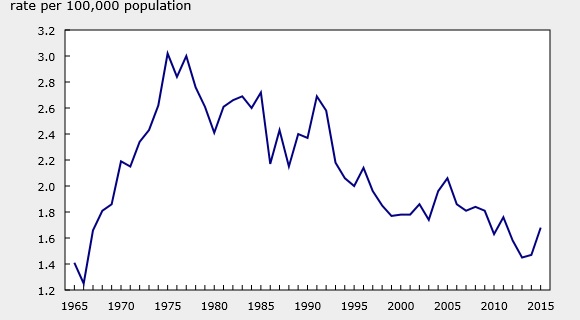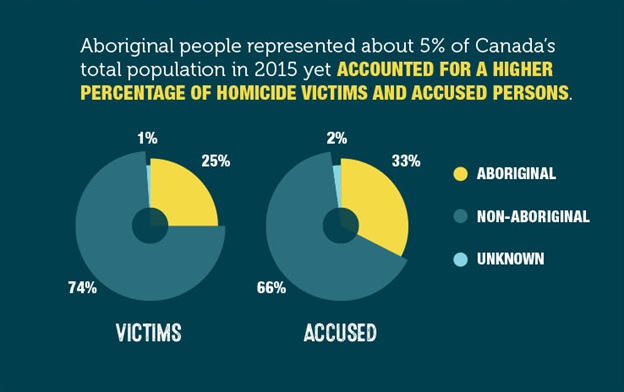Posts Tagged ‘Waterloo Region’
Posted on: April 5th, 2017 by Waterloo Region Crime Prevention Council
On March 30th and 31st 2017, the Waterloo Region Crime Prevention Council hosted the 2017 Canadian Municipal Network on Crime Prevention (CMNCP) at the Walper Hotel. During this two-day event, members of the network, representing 24 different municipalities across the nation, attended interactive lectures led by leaders in public engagement, mental health, and community development. They participated in round table discussions pertaining to increasing both the capacity for crime prevention as a whole and the CMNCP capacity.
Attendees also had the chance to network with other members regarding their experiences with crime prevention in their own municipalities. It was a pleasure to host this hardworking group here in Waterloo Region. We look forward to the continued work ahead!

The attending CMNCP members at the reception hosted by Waterloo Region Chair, Ken Seiling. -Waterloo Region Museum.
A few additional photos of the event proceedings
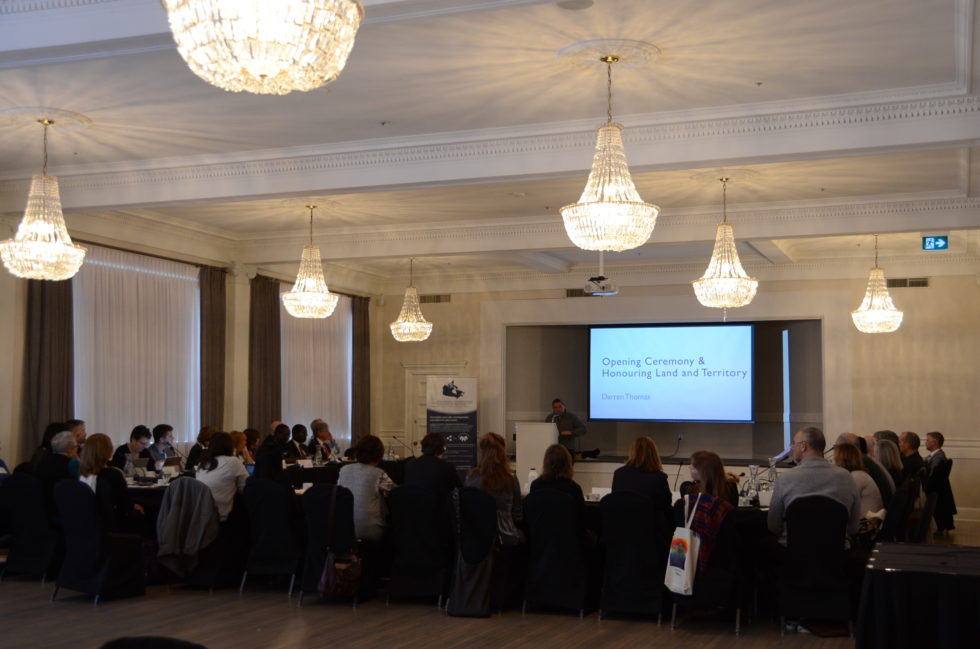
The CMNCP National Meeting was kicked off with an Indigenous Welcome & land Acknowledgement by Darren Thomas
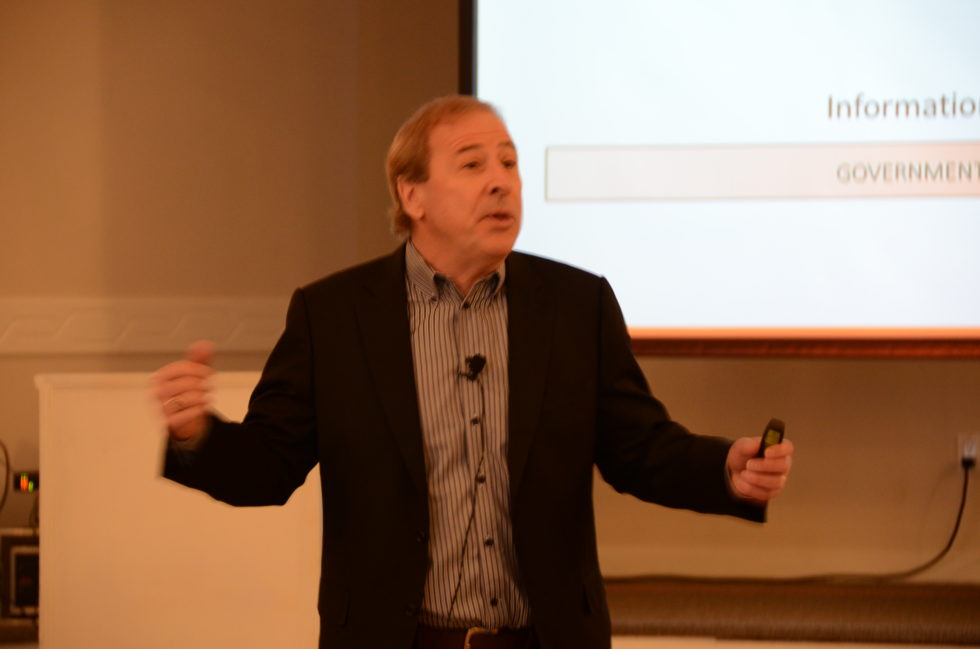
Presentation & Dialogue with Don Lenihan on Public Engagement with Government & Community

Professor Irvin Waller from the University of Ottawa speaking during the CMNCP national meeting
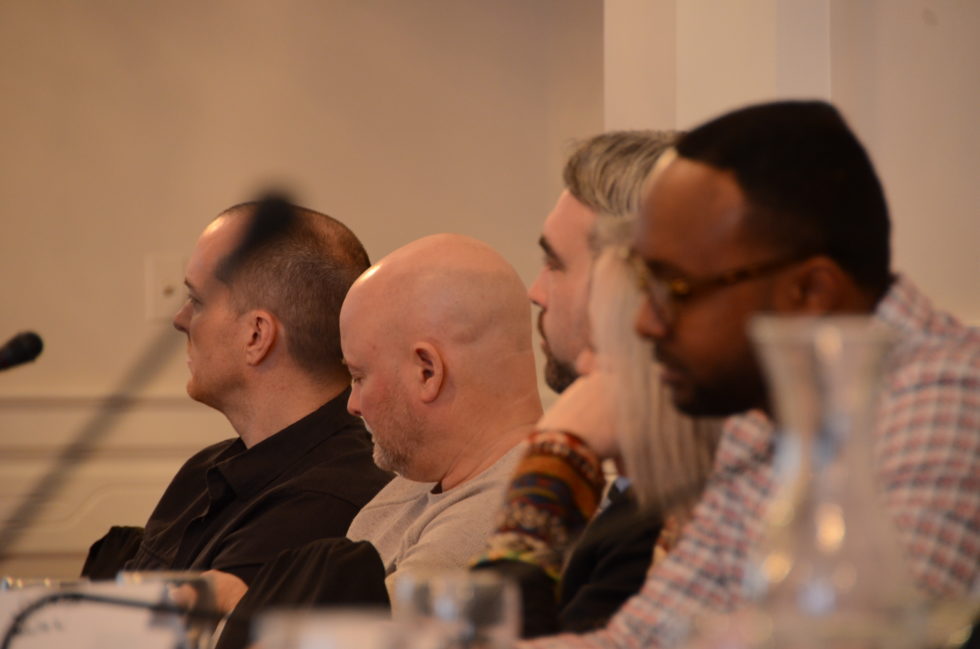
Members of the CMNCP listening intently to a presentation.

Felix Munger had the distinguished task of keeping the CMNCP proceedings on schedule!
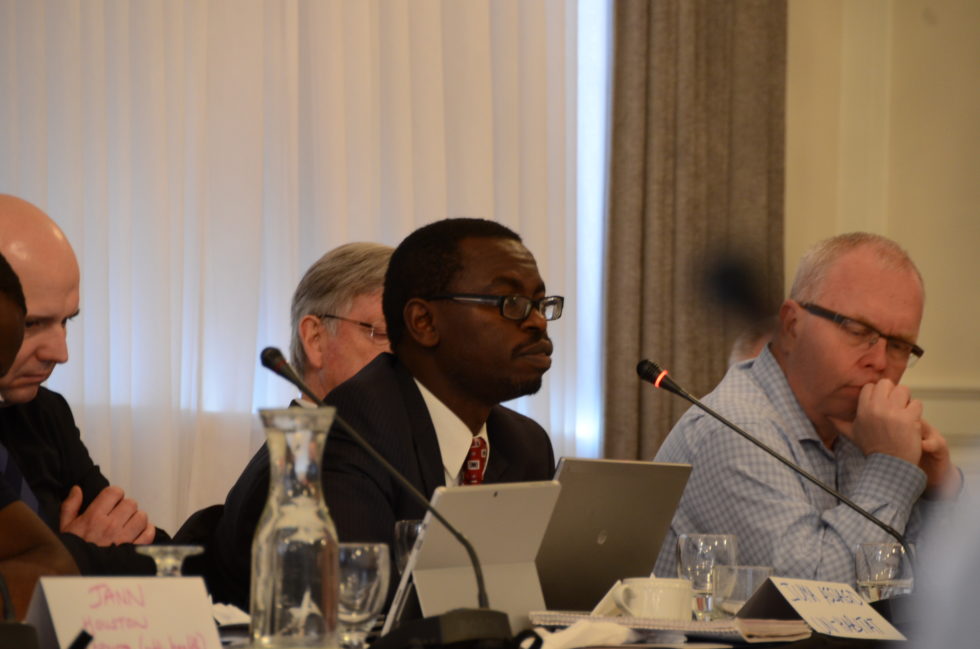
We were very pleased to host Juma Assiago from the UN- Habitat program at CMNCP. Juma supports international cities wanting to address complex crime issues through ‘safe city’ initiatives.

As this was a national meeting, all proceedings were delivered via simultaneous translation
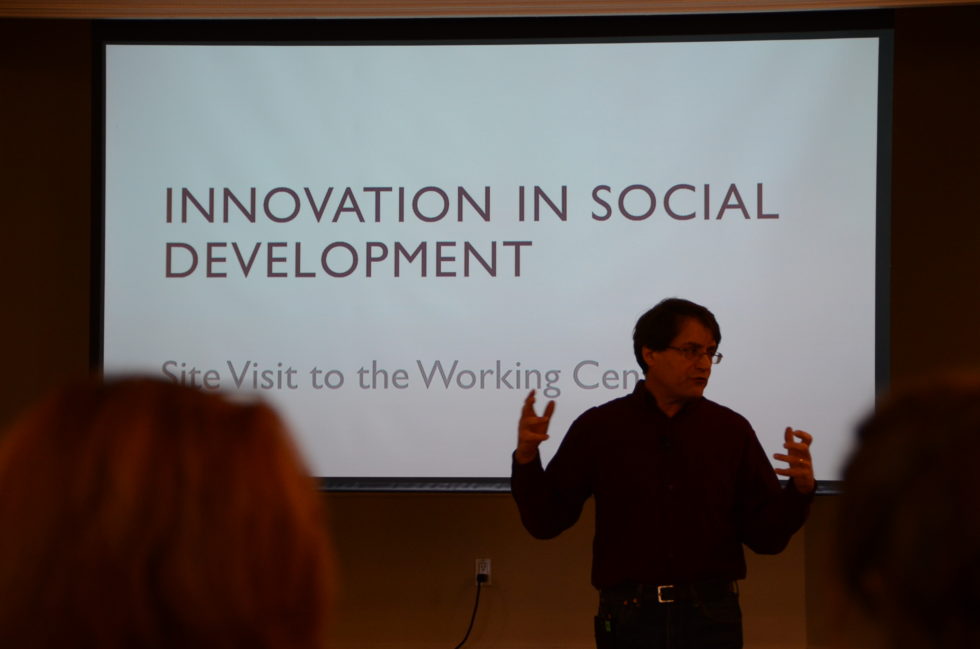
Joe Mencini from the Working Centre explaining the ins-and-outs of the community agency
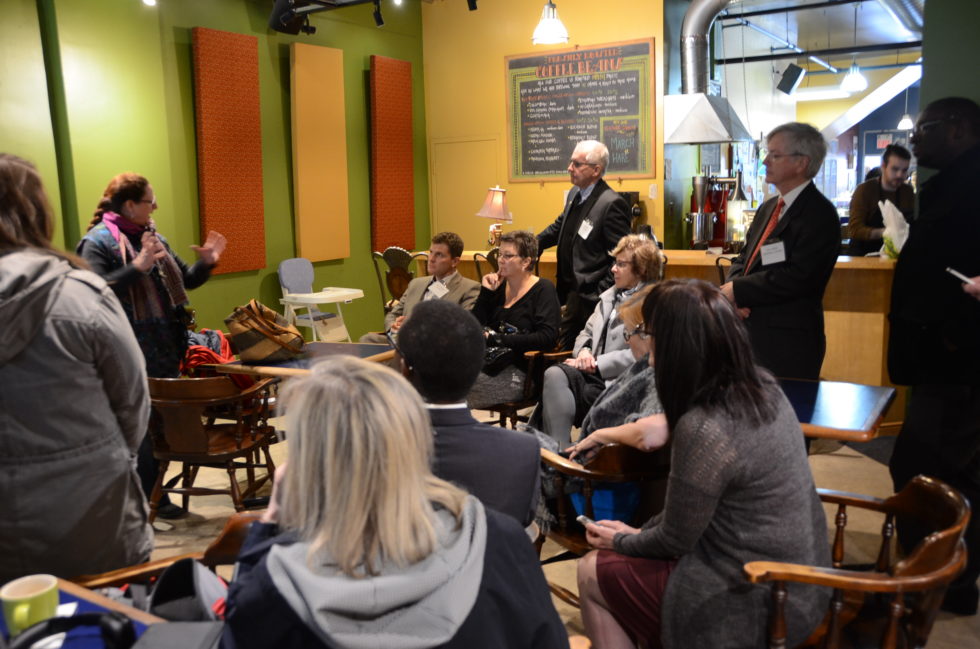
The group gets to leave the meeting table for a field trip to The Working Centre
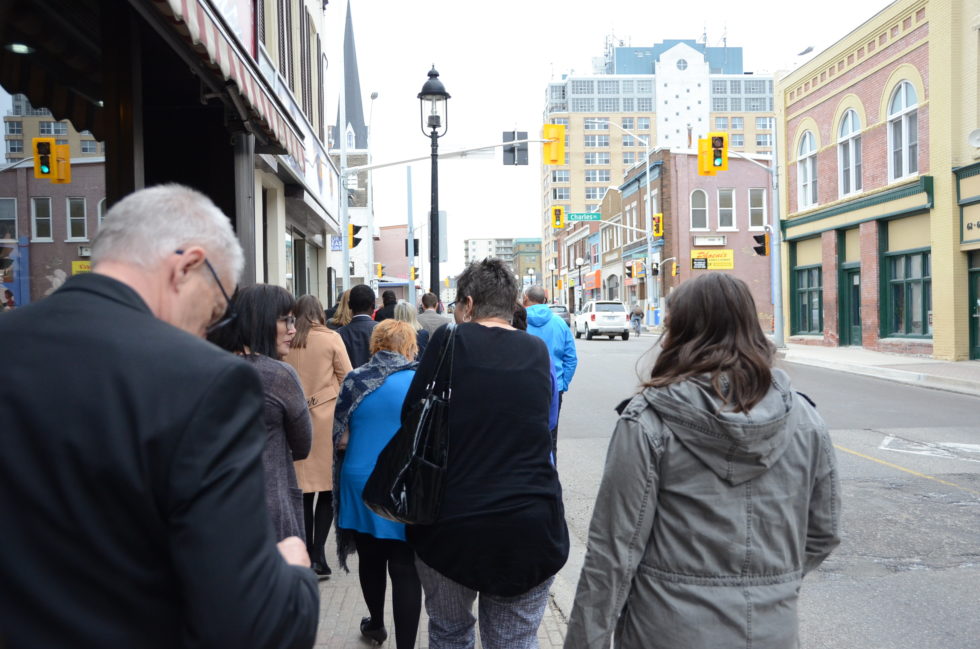
The group gets to leave the meeting table for a field trip to The Working Centre
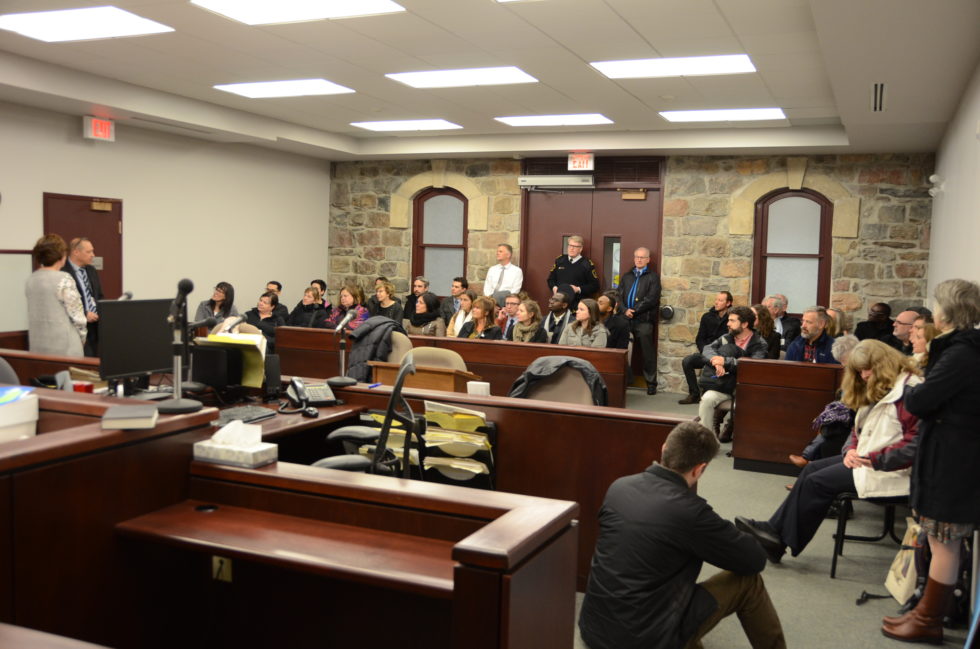
Members of the CMNCP make a visit to the WRCPC office & historic goal in downtown Kitchener

Chief Bryan Larkin of the Waterloo Region Police Services speaking at the Gaol

Regional Chair Ken Seiling was the host for the CMNCP reception held at the Waterloo

CMNCP Co-Chair Patrice Allard speaking at the reception.
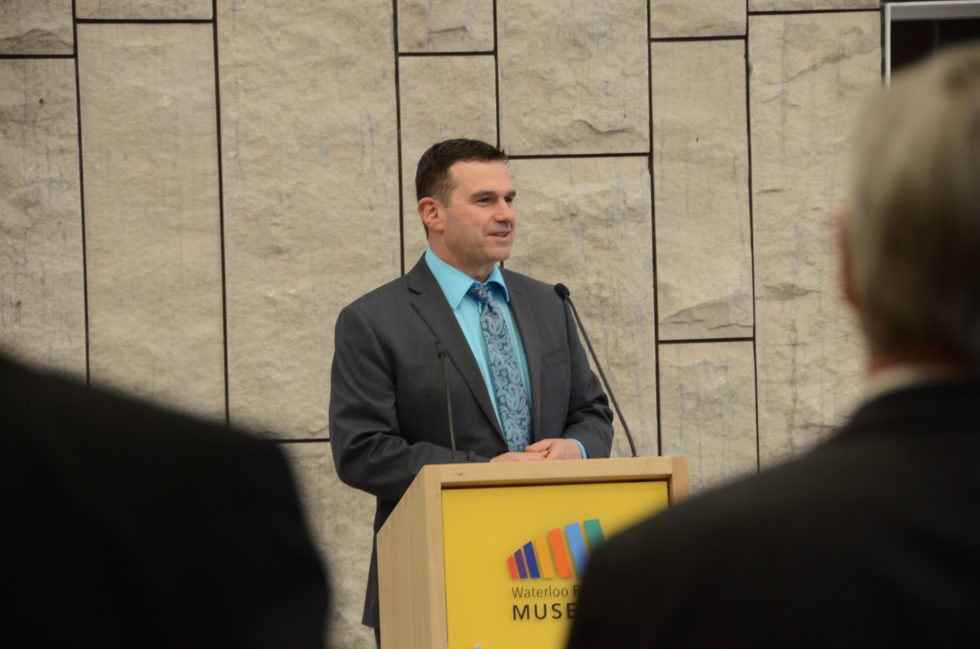
Deputy Chief Kevin Thaler of the Waterloo Region Police Services giving a speech at the reception
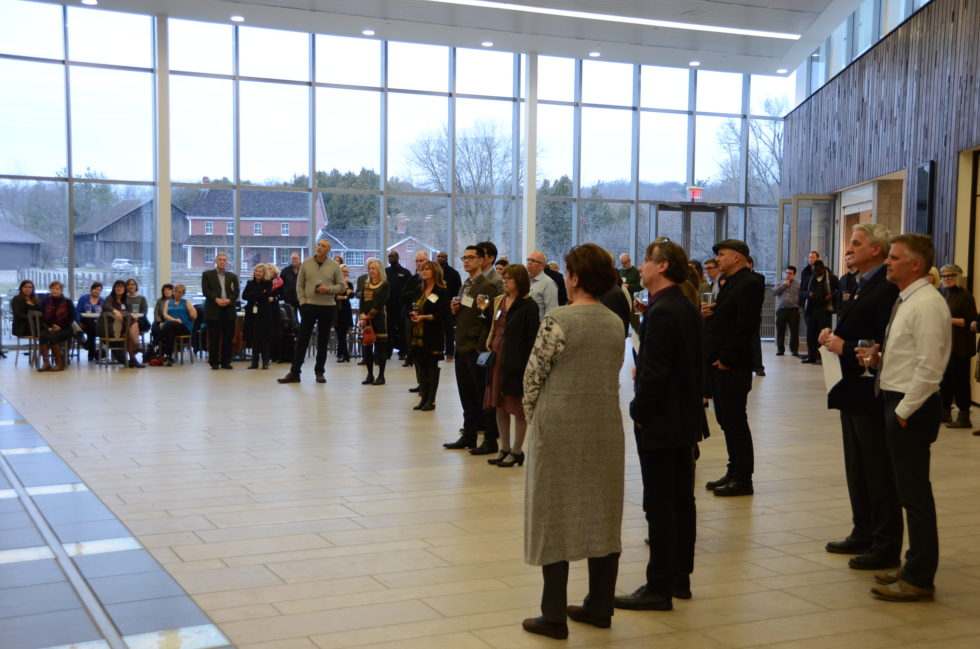
CMNCP members gather around the podium at the Waterloo Region Museum for a welcome address.
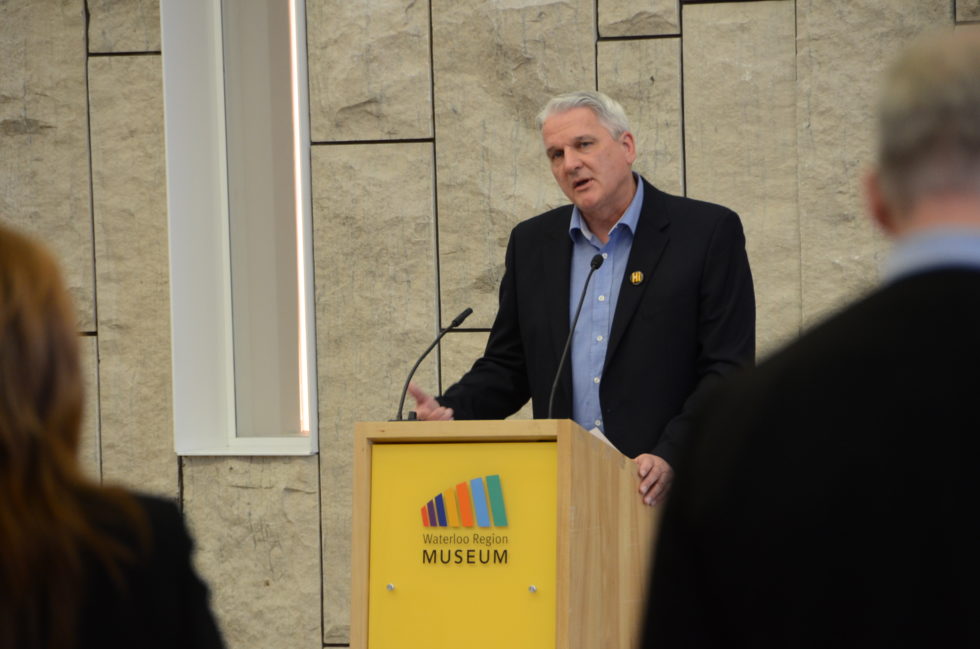
WRCPC Chair Shayne Turner speaking to the guests at the reception
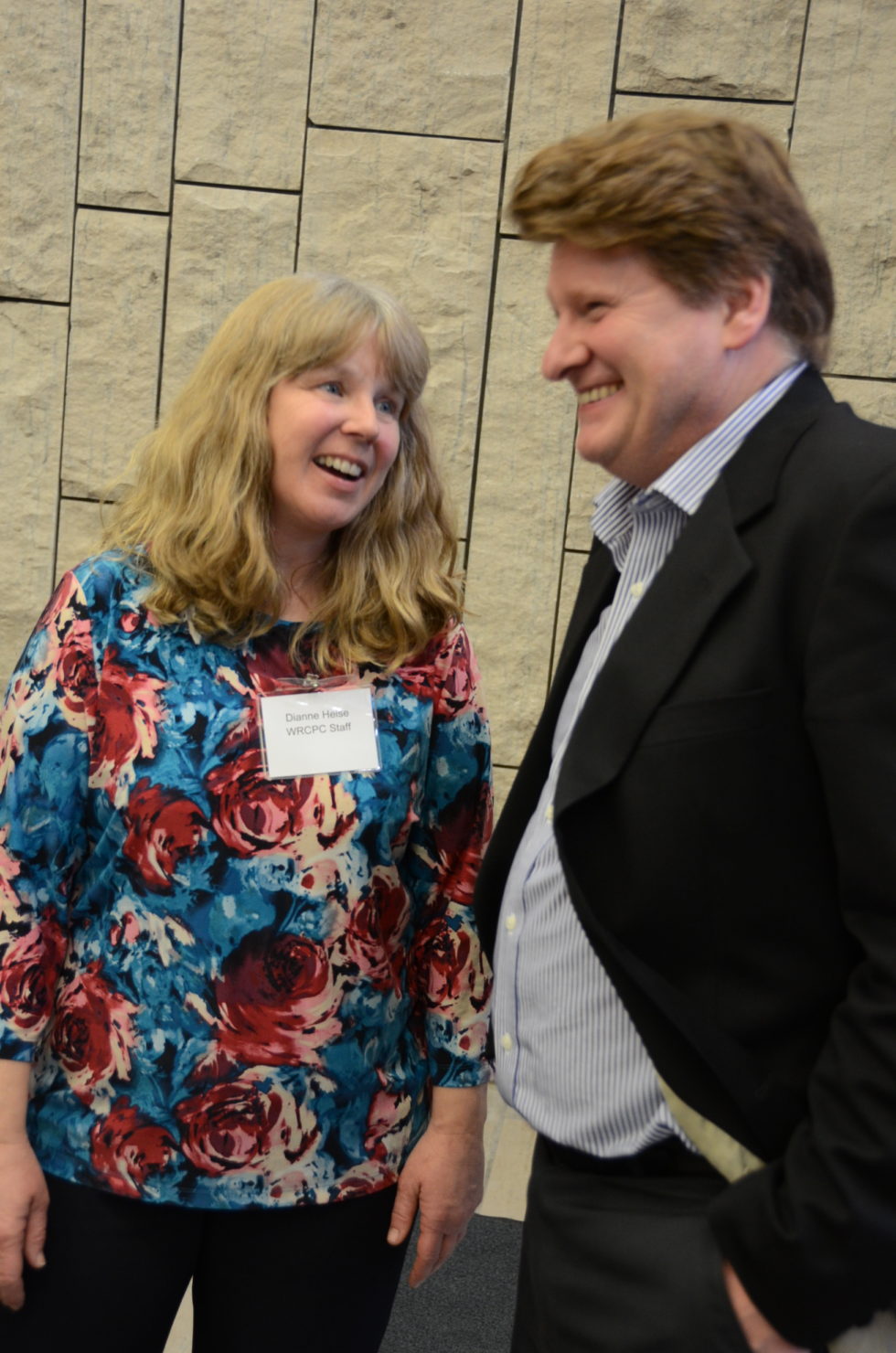
Dianne Hiese & Chris Cowie catching up at the reception
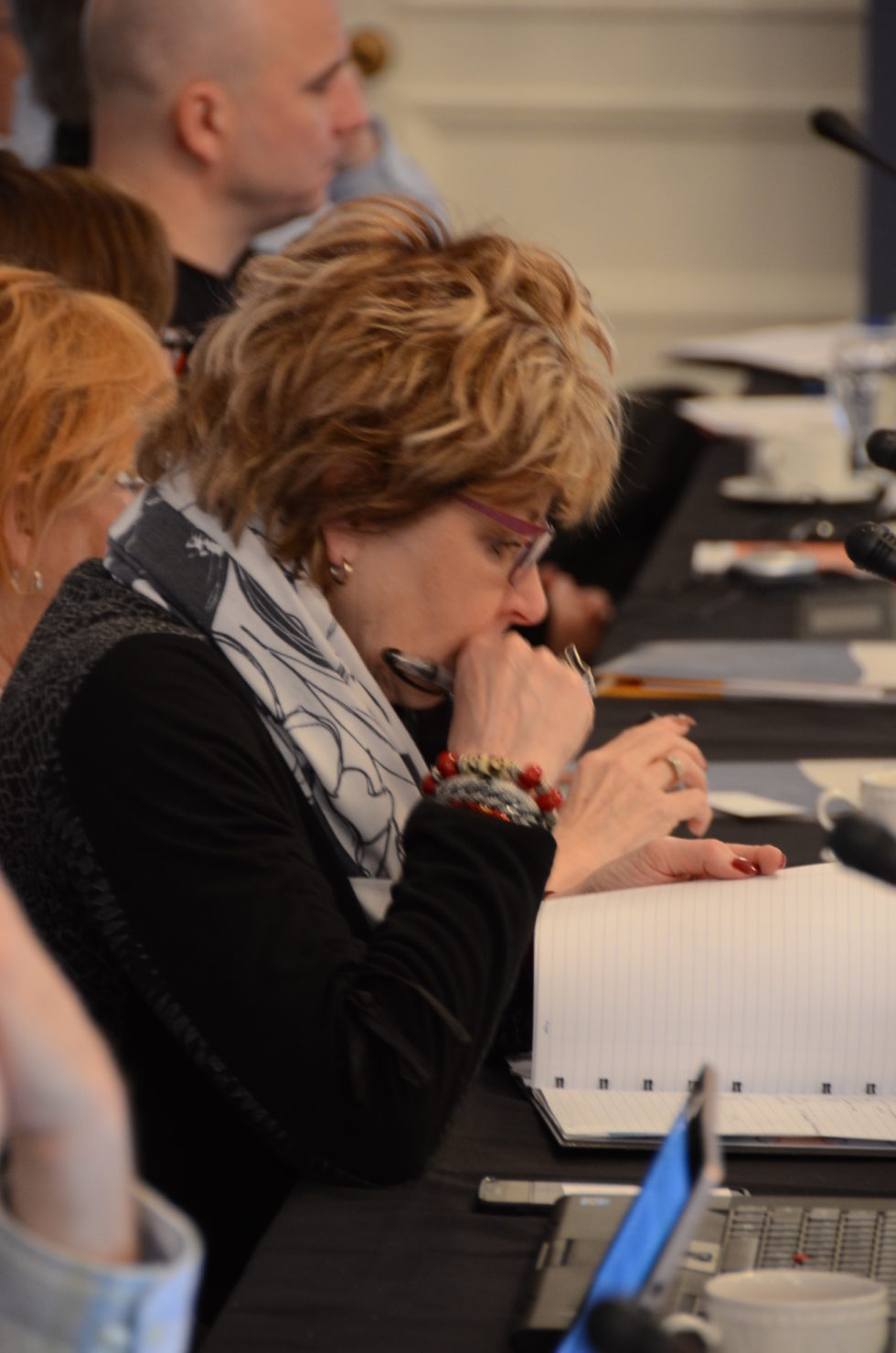
Hard at work during meeting sessions
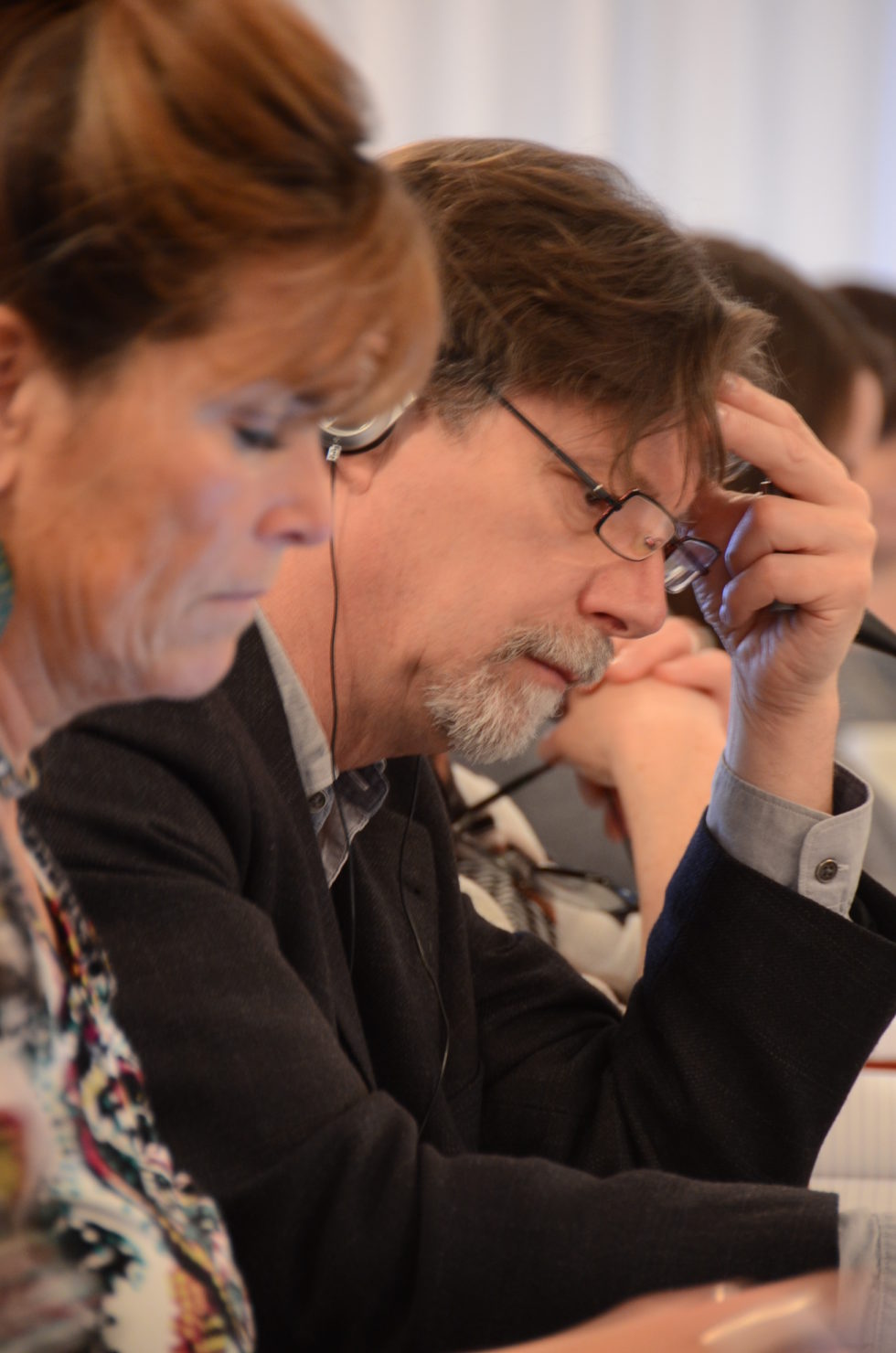
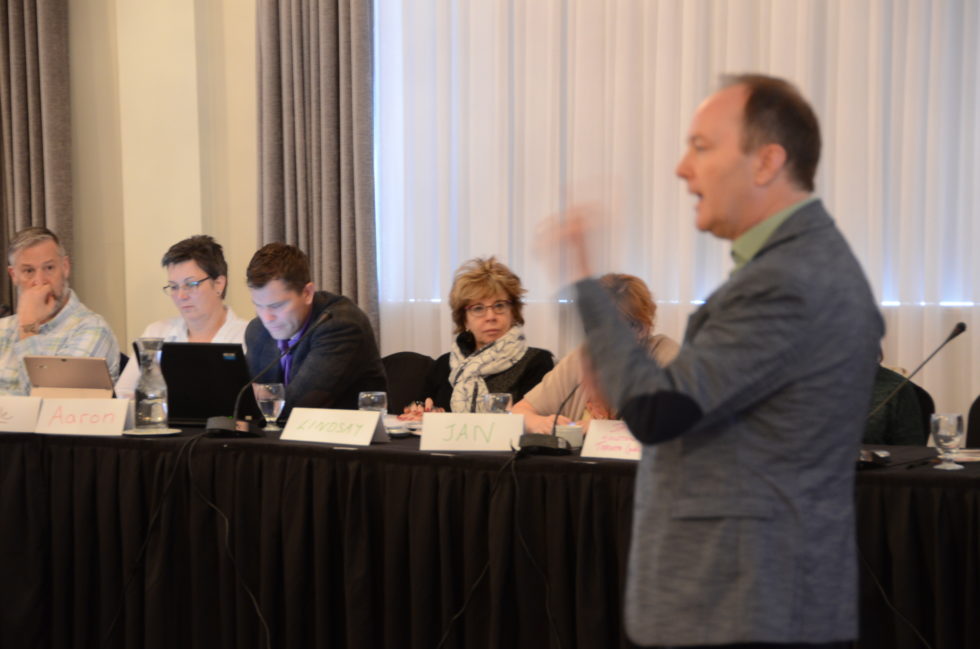
Patrick Smith delivers a presentation on the “Potential of Federated Organizations”
Posted on: January 16th, 2017 by Waterloo Region Crime Prevention Council
Homicide rates rose in 2015 in Canada, Ontario, and Kitchener-Cambridge-Waterloo census metropolitan area (CMA).[1] It will remain to be seen over the next few years whether this represents a notable change or simply reflhttp://ftn#1ects year-to-year variations in rates. Nonetheless, homicide rates in both Ontario and the Kitchener-Cambridge-Waterloo CMA continue to be below the national average, and Canada’s homicide rate has been dropping overall since 1975. What we do see is that homicide continues to impact some groups more than others, including Aboriginals, males, and those living in the Prairie Provinces.
The homicide rate in Canada rose in 2015 by 15%, reaching its highest levels since 2011. In 2014, there were 521 homicides, while in 2015, there were 604, increasing the homicide rate per 100,000 Canadians from 1.47 to 1.68.[2], which is still 2% lower than the average rate for the ten-year period between 2005 and 2014.[3]
Ontario also saw an increase in the homicide rate from 1.14 to 1.26. The Kitchener-Cambridge-Waterloo CMA also saw an increase in homicides from 3 to 6, with a corresponding increase in the homicide rate from 0.56 to 1.11, but these numbers are more variable because of the lower number of homicides.
Homicides in Canada, 1964-2015:
What has changed
2015 saw increases in homicide both involving firearms and involving gang violence. In Canada in 2014, 155 homicides were committed with a firearm, compared to 178 in 2015, an increase of 15%, and the highest number since 2008. Gang-related homicides also increased from 82 in 2014 to 98 in 2015, an increase of 20%, and the highest number of gang-related homicides since 2011.
The number of homicides increased primarily in three provinces: Ontario, which had 18 more homicides for a local increase of 23%; Alberta, which had 27 more homicides for a local increase of 25%; and Saskatchewan, which had 19 more homicides for an increase of 79%.
However, not all changes in homicide rates were increases.
- Homicides by strangers dropped by 21% from 73 to 58 between 2014 and 2015. Conversely, 87% of victims knew those accused of their homicides.
- Intimate-partner homicides remained relatively stable, with 83 such homicides in 2015 compared with 80 such homicides in 2014.
Continuing Patterns
Homicide continues to affect certain portions of the population and certain parts of Canada more than others.
- Homicide continues to disproportionately involve Aboriginal Canadians, with 25% of homicide victims and 33% of those accused of homicide being Aboriginal, though Aboriginals make up only 5% of the population.
Homicides among Aboriginal people in Canada:
- Males continue to be over-represented when it comes to homicide, accounting for 71% of homicide victims and 88% of those accused of homicide.
- Homicide continues to be overly prominent in the Prairie Provinces, for all of which homicide rates are now over 3 per 100,000, with Saskatchewan’s and Manitoba’s rates being more than double the national average.
Putting It All Together
Homicide provides a significant cost to Canadian society. According to a research report by Public Safety Canada, each homicide costs Canadians between $4.8 and $5.9 million.[4] These costs, along with the human costs of homicide, provide important incentives for monitoring and reducing the number of homicides in Canada.
Though homicide rates increased between 2014, it is difficult to say what this means. There have been similar spikes before, such as in 2011, when the rate spiked by 8% only to drop by over 10% the next year. Ontario witnessed a similar spike and drop between 2005 and 2006. In regard to the Kitchener-Cambridge-Waterloo CMA, because there are so few homicides, the homicide rate is likely to vary from year to year, with 8 homicides in 2013, then 3 in 2014 and 6 in 2015. It would take several years of higher rates before any continuing pattern could be identified. Nonetheless, the homicide rate in Ontario of 1.26 per 100,000 remains below the national average of 1.68, as does the homicide rate in the Kitchener-Cambridge-Waterloo CMA at 1.11 per 100,000. Overall, homicide has been on a decline since a national high of 3.02 in 1975. What we do see is that homicide continues to impact some groups and areas more than others, including Aboriginals, men, and the Prairie Provinces.
[1] The Kitchener-Cambridge-Waterloo census metropolitan is the Region of Waterloo excluding the Township of Wellesley and the Township of Wilmot
[2] Unless otherwise noted, all statistics are derived from Mulligan, L., Axford, M., and Solecki, A. (2016). Homicide in Canada: 2015. Ottawa: Statistics Canada. Retrieved on January 16, 2017 from http://www.statcan.gc.ca/pub/85-002-x/2016001/article/14668-eng.pdf.
[3] Statistics Canada. (2016). Homicide in Canada: 2015 [fact sheet]. Ottawa: Statistics Canada. Retrieved on January 25, 2017 from http://www.statcan.gc.ca/pub/11-627-m/11-627-m2016008-eng.htm.
[4] Gabor, T. (2015). Costs of Crime and Criminal Justice Responses. Public Safety Canada. Retrieved on January 16, 2017 from http://www.statcan.gc.ca/pub/85-002-x/2016001/article/14668-eng.pdf, p. 6.
Author: Daniel is an MSW student with the Waterloo Region Crime Prevention Council working on various research projects and community engagement initiatives. Daniel holds a doctorate in philosophy from the University of Toronto, where he taught for six years. He now runs a mediation and psychotherapy practice in downtown Kitchener while completing a master of social work degree at Wilfrid Laurier University.
Posted on: November 23rd, 2016 by Waterloo Region Crime Prevention Council
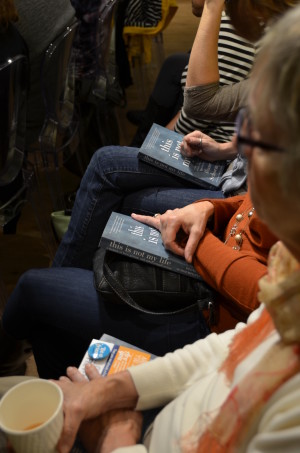 All of the calls to action already mentioned in the previous blog posts (humanizing people in prison & advocating for programs that work) help to create and strengthen system change in big and small ways. The work of larger structural change is long term, often slow work: Not for the faint of heart, but everyone can still play a role.
All of the calls to action already mentioned in the previous blog posts (humanizing people in prison & advocating for programs that work) help to create and strengthen system change in big and small ways. The work of larger structural change is long term, often slow work: Not for the faint of heart, but everyone can still play a role.
Here are a few ways you or your friends can contribute toward society and system changes.
- Male Allies Against Sexual Violence – Through public education, the Male Allies program invites men and boys to be leaders in the work of ending gender-based violence. Their goal is to encourage critical introspection in men and boys, which begins by helping them to understand gender-based violence as a men’s issue. Over the past eight years, they have offered hundreds of workshops to thousands of men and boys and have just started a ground-breaking training initiative with the Ontario Hockey League.
- Learn more about the root causes of crime. In order to prevent something, it’s important to understand the contributing factors. As a community, we have the responsibility to address these conditions which hinder healthy development and can lead to criminal behaviour.
- Learn more about Smart on Crime approaches to addressing crime. Everyone has heard about tough on crime, but what about Smart on Crime? As a community, we can use language that shows we can build a community that is safe and vibrant for all people living in Waterloo Region.
- Follow the advocacy work of Howard Sapers – Until recently, Howard Sapers was the Correctional Investigator of Canada responsible for the investigation of individual and systemic concerns. He was also a guest for a 2015 Friends of Crime Prevention event. On November 8, the Ontario Government appointed Mr. Sapers to be an independent advisor on corrections reform and to provide advice to the government on the use of segregation and ways to improve the province’s adult corrections system.
When we have people and community organizations working at all three areas of action to humanize people in prison and reduce stigma for loved ones, advocate for programs that work and enter into deeper levels of system and societal change, we can move the needle on progressive change.
If you decide to take some action, we would love to hear about it – 6 weeks from now, or 6 months from now! Get in touch with Juanita Metzger to share your story.
Posted on: November 23rd, 2016 by Waterloo Region Crime Prevention Council
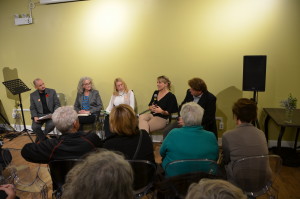 The Turn the Page book club stimulated a great deal of discussion about the stigma. Society, in general, has a negative stigma against people that have been in prison and often their family member and children too.
The Turn the Page book club stimulated a great deal of discussion about the stigma. Society, in general, has a negative stigma against people that have been in prison and often their family member and children too.
People began to ask questions: How do we change this attitude in society and within ourselves? Given that we have a federal prison for women right here in Waterloo Region, how can we help within our own community? How can we get involved?
We’ve pulled together a range of potential ‘calls to action’ that help to humanize people in prison & reduce the stigma of loved ones. As Diane and the panelists reminded us, people in prison will leave prison when their sentences end and return to our communities. Reintegration to life on the ‘outside’ doesn’t happen by magic.
There are countless ways to be involved, likely more than we have to share, but here’s a start.
To start.. Read the Book! If you didn’t get a chance the first time around, it’s still available to borrow at KPL, WPL and Cambridge or get it for sale at Wordsworth Books in Waterloo. We developed a reading guide that might be helpful for checking some of your assumptions and thinking broadly about this issues Diane challenges us with.
If you have a book club, get them to read the book too! We’ve even created a handy Reading Guide to accompany the book.
One of the best ways to start in this area is to work directly with or support the organizations that work with inmates and their families.
- STRIDE is a program of Community Justice Initiatives. STRIDE helps women in prison build informal networks of support that assist them as they reintegrate back to the community. They also prepare the community to receive them safely and supportively. CJI has several other programs that offer support to offenders.
- John Howard Society Waterloo-Wellington offers diverse prevention, diversion, intervention and educational services for children, youth and adults who are in conflict with the law or at risk of getting there.
- Elizabeth Fry Society for Kitchener Waterloo provides gender-specific services, support and advocacy for women within the community, involved in a judicial process or who are serving sentences at Grand Valley Institution for Women, a federal prison for women located in Kitchener.
- Volunteer at Grand Valley Institution – The Correctional Service of Canada has a volunteer program that works directly with recreational activities, classroom and workshop instruction, and cultural or chaplaincy activities and supports families of offenders or helping released offenders re-adjust to life.
These are all very different volunteer opportunities and if you are very interested, best to do the research and find the best fit for you and your interests. You might discover that you prefer a community based approach rather than a formal institutional setting.
Check out the ‘calls to action’ related to advocating for programs that work and creating system change.
Posted on: November 23rd, 2016 by Waterloo Region Crime Prevention Council
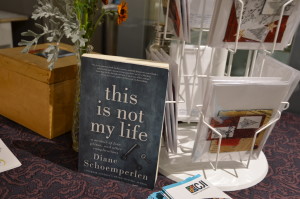 At first glance, Diane Schoemperlen’s memoir “This Is Not My Life: A Memoir of Love, Prison, and Other Complications” seems straight forward, in its own way, the stuff of TV shows and movies…. An author meets a fellow volunteer at a Kingston soup kitchen whom she knows has been is in prison, they become friends, they eventually develop an intimate partner relationship, they try to navigate the world inside prison and outside prison, they try to manage life together on the outside, the author leaves the relationship that has become abusive and spends the next six years healing and putting her life back together.
At first glance, Diane Schoemperlen’s memoir “This Is Not My Life: A Memoir of Love, Prison, and Other Complications” seems straight forward, in its own way, the stuff of TV shows and movies…. An author meets a fellow volunteer at a Kingston soup kitchen whom she knows has been is in prison, they become friends, they eventually develop an intimate partner relationship, they try to navigate the world inside prison and outside prison, they try to manage life together on the outside, the author leaves the relationship that has become abusive and spends the next six years healing and putting her life back together.
After spending an evening with Diane at the Turn the Page Book Club hosted by the Friends of Crime Prevention we have a deeper understanding of the complexity of this story. The story of their relationship covers tough issues tied to root causes of crime, such as family violence, sexual violence, and problematic substance use. Schoemperlen is unflinching in assessing her own motivations for staying in the relationship, as she comes to know the shadow and stigma that institutionalization casts over inmates and their loved ones.
Maybe slightly unorthodox for your average book club, Friends also brought together a community panel of Jennifer Hutton (Women’s Crisis Services of Waterloo Region), Chris Cowie (Community Justice Initiatives) and Shannon Moroney, author of Through the Glass to discuss the themes of the book in more depth and draw some direct applications to our community.
From the discussions between Diane & the panelist and the question/answer period with the community readers, we covered more content and topics than your average university course! Discussion ranged from childhood abuse/trauma to incarceration rates, from restorative justice to the lack of helpful prison programs, from reintegration challenges for released inmates to stigma faced by loved ones and family members of inmates, from abusive relationships to support networks for families of inmates, from the prison industrial complex to… well, I think you get the idea. Diane’s is a personal story that shines a light, not only on her own experience, but deftly directs a laser beam at the prison system in Canada. Diane skillfully tells a political story through her own story – a story that concerns us all.
Over the course of the discussion, people began to ask questions: What we can do to change a system that is clearly not working? Given that we have a federal prison for women right here in Waterloo Region, how can we help within our own community? How can we get involved?
We’ve pulled together a range of potential ‘calls to action’ and avenues for participating in creating change. Clicking on the links here will get you started.
If you decide to take some action, we would love to hear about it! Get in touch with Juanita Metzger to share your story.
Posted on: March 25th, 2015 by Smart on Crime
Never have I seen such a beautiful collection of voices, all unique, and yet all singing the same tune. The Everyday: Freedom from Gendered Violence Symposium put on by the Social Innovation Research Group, and brilliantly detailed by Jay Harrison here, was a phenomenal representation of the intersection of research, arts, and community work. While the Symposium had a particular focus on the university experience, its messages are equally applicable in our neighbourhoods and communities as we think about crime prevention and smart approaches to the gendered violence that occurs in those spaces.
I don’t think I could ever do justice to the amazing topics that were discussed – responding to disclosure, the particular experiences of gendered violence faced by racialized and LGBTQ students, engaging men in prevention, and more. So, I thought the best way was to provide some insight from the speakers themselves:
“What does it mean to be safe?” –Dr. Jenn Root
I sat and thought, ‘good question!’ How can we talk about safety without first talking about what that means? Discussions of violence and crime prevention should always start at the roots.
“Public space is not equal for everyone.” –Tatyana Fazlalizadeh
This rang true for me. How many times have I called a friend or family member to pick me up because I didn’t want to walk alone?
“Did that really just happen?” –Dr. Michael Woodford
Dr. Woodford was speaking about the slurs and comments made to LGBTQ students. But for me, I was struck by the thought of how often we doubt ourselves, as well as our friends and our families when they tell us about something seemingly “minor” is said to them: ‘Oh come on, it’s not so bad…’
“Street Harassment is abuse.” –Tatyana Fazlalizadeh
Tatyana amazed me with this beautiful comparison of street harassment to domestic violence: if a man was yelling derogatory names at his wife, we would call it abuse. When women have cat-calls yelled at them from across the street, however, we tend to brush it off and ignore it.
“The kind of terrorism I want to talk about in this country is domestic violence.” –Judah Oudshoorn
While the media and our governments continue to feed us horrible stories of the atrocities occurring under the umbrella of terrorism, sometimes we forget about the atrocities happening much closer to home – maybe in our homes, maybe in our neighbour’s home.
“Sexual violence is a strategy of war – it is not just against the women, but also the community – it is an attempt to demoralize the community.” –Dr. Eliana Suarez
At the Crime Prevention Council, we often talk about the role of community as a building block for crime prevention. If sexual violence is designed to demoralize a community, then we, as that community, must take a leading role in preventing it.
“Either you’re violent, silent, or creating meaningful change. And if you’re silent, you’re violent.” –Judah Oudshoorn
What a powerful statement. I know which role I choose to play.
“Women are not just resilient, they are resistant – they attempt to change their circumstance.” –Dr. Eliana Suarez
“Maybe there is more than one way to be a man.” –Stephen Soucie
I felt these two quotes belonged together. Discussions around gendered violence often leave me feeling sad and hopeless. But these two spoke of hope, optimism, and change for both men and women.
“It is easier to build stronger children than to fix broken men.” –Stephen Soucie
Again, I felt another ray of hope. Through my research at the Crime Prevention Council, I have learned that early interventions have astonishing success in reducing rates of crime. This is where I think we should be investing our time, energy, and dollars.
“Compliance is important, but compassion is more important.” –David McMurray
An important reminder to wrap things up: while being “tough on crime” continues to get lots of media attention, we would be wise to look at the evidence base and the fact that the majority of “tough on crime” approaches do nothing to reduce crime. Early intervention, prevention that is proven to work, and renewed focus on humane approaches to rehabilitation and reintegration, would go much further toward reducing incidents of crime and victimization.
There were a myriad of other speakers who had insightful comments, but unfortunately, I am only able to present a small portion here. The passion in the room from each and every speaker was evident – from the researchers to the artists to the community workers. They all shared with us their struggles, and yet I came out the other side feeling hopeful and fulfilled. If they can commit themselves to this struggle, they must feel that it is important and that change can be made. As I move forward in working on my Master of Social Work thesis next year, which touches on this topic, I feel like maybe I can contribute a small portion to this struggle. Maybe, someday, we could live in a world where everyday, we were free from gendered violence.
“The struggle is real… the struggle continues” –Janice Lee
How are YOU contributing to the struggle?

Eleanor McGrath
Author: Eleanor is a Master of Social Work student at Wilfrid Laurier University. She is completing her first placement at the Waterloo Region Crime Prevention Council, working on a narrative literature review of how crime mapping can be used to implement community-based prevention initiatives. Her favourite hobbies are laughing, rock climbing, and travelling.
Posted on: February 25th, 2015 by Smart on Crime
That’s the response I usually get from friends and family when I tell them that I’ve spent the past two years coordinating a project to address gendered violence against university students. I generally concur with the exasperation, but am quick to point out that it seems unfair to expect to see less gendered violence on campus when relatively little has changed in how we address it on university campuses and in the surrounding communities in which university students live, work and play.
JOIN OUR 2-day Symposium
March 11th & 12th
Engage with campus and community participants on issues related to gendered violence against students in our community.
|
The Change Project, a university-community collaboration funded by Status of Women Canada and led by the Sexual Assault Support Centre of Waterloo Region has taken a long view approach to working toward safer campuses in our region. Over the past 2 years we have talked to over 650 students, staff, faculty and community stakeholders at Wilfrid Laurier University and the University of Waterloo as part of 2 separate needs assessments. The goal of this work has been to understand what our institutions of higher learning are doing well in terms of addressing gendered violence – both in its prevention and response – and what still needs to be done. Ultimately, our aim was to end gendered violence on campus through transforming the institutional and cultural climate of the universities and communities.
Both universities have remarkable capacity to address gendered violence and we have been inspired by the growing attention they have paid the issue over the course of the project. They are also aware of some of the gaps that need to be filled and have begun to demonstrate their capacity to do so in earnest.
What we have learned is that gendered violence – including sexual assault, sexual harassment, intimate partner violence, stalking, biphobia, transphobia and homophobia – is ubiquitous; that is, it happens wherever students are. For students in Waterloo Region that means they are encountering violence in their classrooms and residence buildings as well as in our community: our restaurants and bars, parks, buses, and neighbourhoods. In fact, previous research suggests that most incidents of sexual violence that students experience happen off-campus, outside of the geographic boundaries of the university. And students experience campus life socially, the social boundaries of which can extend quite deeply into our community.
I think this points to a need to look at gendered violence against students as a whole community concern. The efforts of our campuses to prevent gendered violence and support survivors will inevitably fall short if we do not start with a definition of the problem that takes the entire community as its focus and potential site of intervention. How we frame the problem will inform what happens next, who acts and how, and who is held accountable for ensuring student, and by extension community, safety. By broadening our frame of reference we also create an opportunity to draw connections between the gendered violence that is experienced by students with the violence experienced by other members of our community. I believe we can open new doors of possibility for developing truly innovative solutions to an age-old problem by connecting the capacity and knowledge that resides in the university with that of the community.
Are you interested in this topic? The Social Innovation Research Group invites you to join us for a 2-day symposium, Everyday: Freedom from Gendered Violence, March 11th and 12th to engage with campus and community participants on issues related to gendered violence against students in our community. Visit the SIRG website for more information about The Change Project.

Jay Harrison
Author: Jay Harrison is the coordinator for The Change Project at the Social Innovation Research Group. She has been working on issues related to gendered violence against students in Waterloo Region since 2005 when she was an undergraduate student at Wilfrid Laurier University. Jay works with social sector organizations in Waterloo Region and beyond to support their social change efforts through research and evaluation.
Posted on: February 13th, 2015 by Smart on Crime
Despite homicide being a rare event in Canada, when it happens, it is the highlight of media headlines. Television news, newspapers, and social media sources all follow the story closely. In parallel to media coverage, there is a steady growth of stories being told about crime. These are found in popular novels writing about true crimes and television dramas sensationalizing the role of police and courts. With all of this attention on crime, it might be fair to imagine that consumers’ craving for violent crime related publications and or news drives its unproportioned publicity and its media focus, however, it is much more complicated to figure out which one comes first.
Homicides attract a great deal of media attention but it’s important to remember that they make up less than 1% of all violent crimes. Although homicide rates decreased last year, the homicides that did occur were heavily reported. The media focus on violent crimes, like homicide, has a great effect on the perceptions of ordinary citizens that leads to inaccurate beliefs that crime has increased. This influence of media on perceptions of crime is evident among the citizens of Waterloo Region. For instance, in the report, Won’t you be My Neighbour, the WRCPC used survey data from 2012 to show that 61% of the respondents think there is more crime Waterloo region today than when they were a child. In addition one-third of Waterloo Region residents think crime has increased over the past five years. This is despite the crime rate having dropped dramatically over the past 25 years in Canada and Waterloo Region. When news media use inflammatory language for front page headlines this can incite fear among readers and viewers and have a profound influence on the public’s perception of violent crimes including homicide.
The rate of homicide in Canada has been in steady decline since the 1980s. In 2013, there were 505 homicides in Canada, 38 homicides fewer than the previous year, marking an 8% decrease in the homicide rate (1.44 per 100,000 population). The homicide rate has generally been decreasing since peaking in the mid-1970s. (see Figure 1- homicide rates 1963 to 2013)
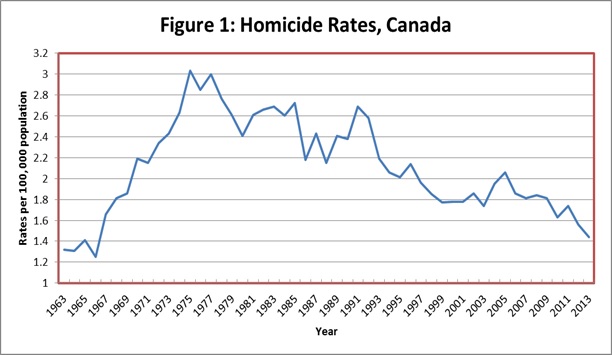
Source(s): Data on homicide are available back to 1961 in CANSIM table 253-0001.
Homicide, police-reported homicide rates, by province and territory, 2012 and 2013
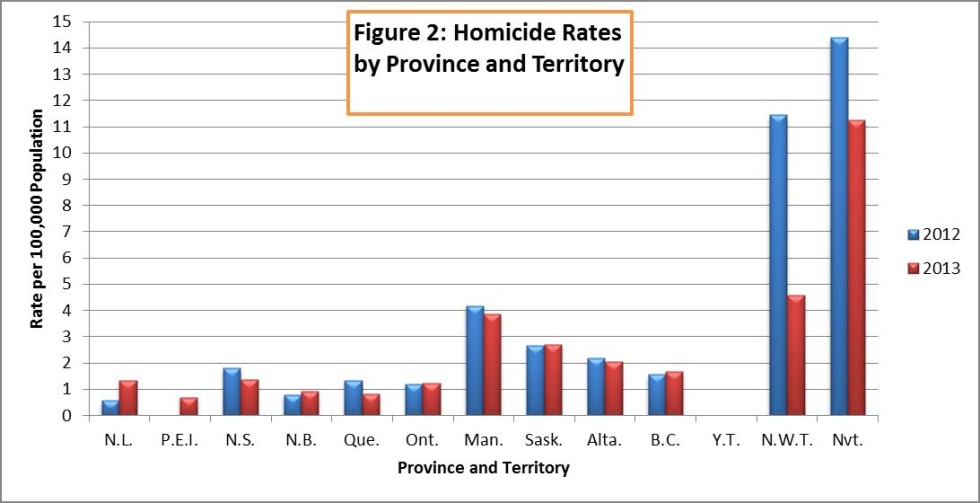
Among the provinces of Canada, British Colombia, Ontario and Newfoundland and Labrador, saw a marginal increase in homicide numbers in 2013. On the other hand, Quebec saw 40 less homicides in 2013 than in 2012. Yukon was the only jurisdiction to report no homicides (See Figure 2). Overall, the number of homicides in Canada continued to decline as of 2013 across most provinces and territories and most census metropolitan areas.
Against this backdrop, crime in Waterloo Region in 2013 showed a one year blip where our homicide rate rose above the Canadian average. From 1981 to 2013 there were 171 homicides in the Kitchener-Cambridge-Waterloo CMA; that’s an average of 5 per year. Looking just at one year snap shots though we see the number rise to as high as 11 and drop to as low as one. A wide fluctuation like this does not mean we should panic if the rate shows a one year blip, nor should we dismiss homicides as a possibility in times when the rate drops. What’s import to examine is the trend over time, which is declining in Waterloo Region just like it is declining in Canada (Figure 3).
Homicide, police-reported rates, Canada, Kitchener/Waterloo/Cambridge – 1981 to 2013
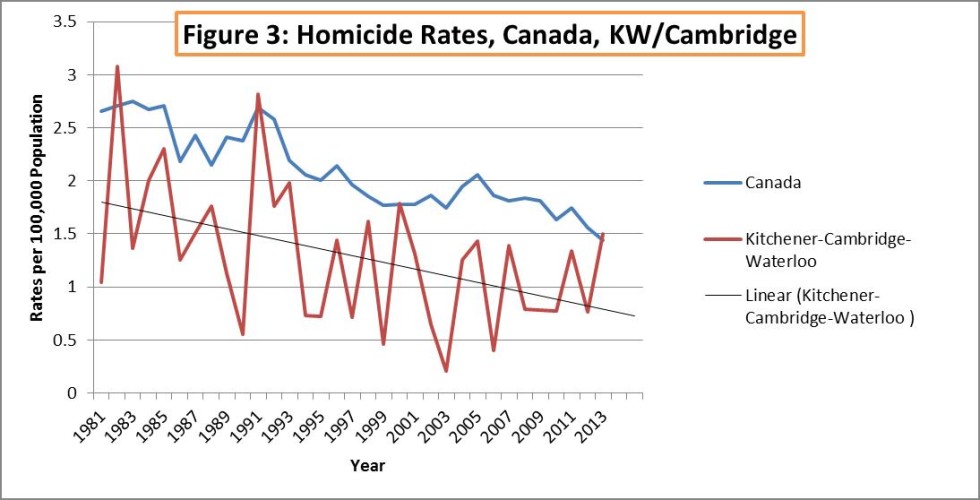
Source: Statistics Canada, Homicide Survey, Canadian Centre for Justice Statistics.
As shown above, the rate of homicides in Waterloo Region rose above the national average in 1982, 1991, 2000, and 2013. Although the increases of the homicide rate in these four years seems alarming, in every other year, stretching 32 years of homicide rate, it was consistently lower than the national average. Waterloo Region is a safe place to live with relatively few homicides. On the other hand, although the Region has a low homicide rate, one major incident can affect the statistical rates and the publication of the event with sensational headlines could incite fear among readers and viewers and potentially trigger unfounded perceptions of crime being on the rise in our community.
What do you think is a good measure of safety in our community?
Author: Asnake Meshesha is a Master of Social Work placement student with the Waterloo Region Crime Prevention Council.
Posted on: February 3rd, 2015 by Waterloo Region Crime Prevention Council
Maybe even much like February 3rd, 2015… cold, crisp and clear, with a bright full moon.
A group of enthusiastic and passionate community leaders presented the work of the Community Safety and Crime Prevention Council to Waterloo Region Council. At the time, they had been operating for almost 2 years! Their proposal on February 3rd, 1995 was to evolve from a ‘task group’ to a more formal entity, with a paid staff!
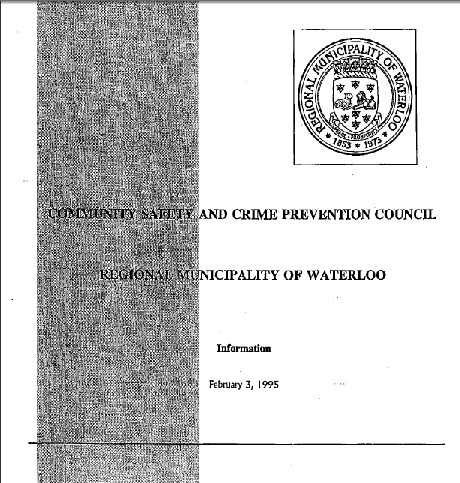

Looking back can be informative… and sometimes cringe worthy! In 20 years, our language and conceptions about crime and crime prevention have evolved so much!


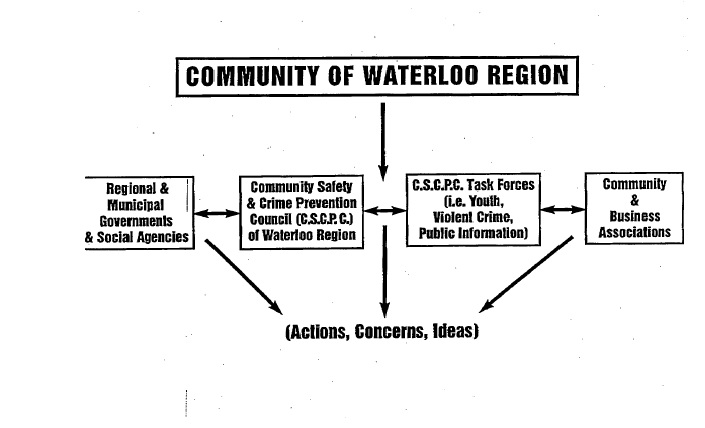
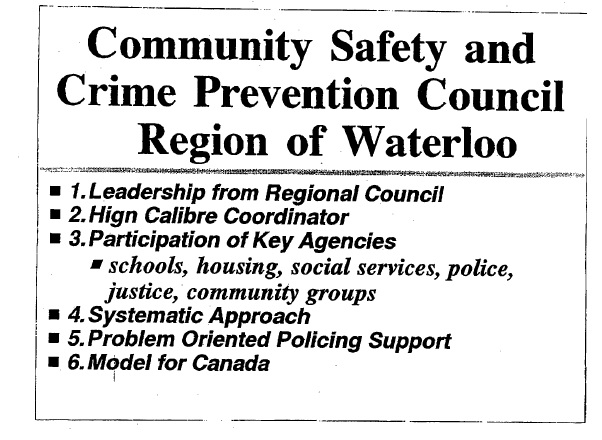
Did you catch point number two?? High calibre coordinator! That’s our very own Christiane Sadeler. She’s still the Executive Director to this day.
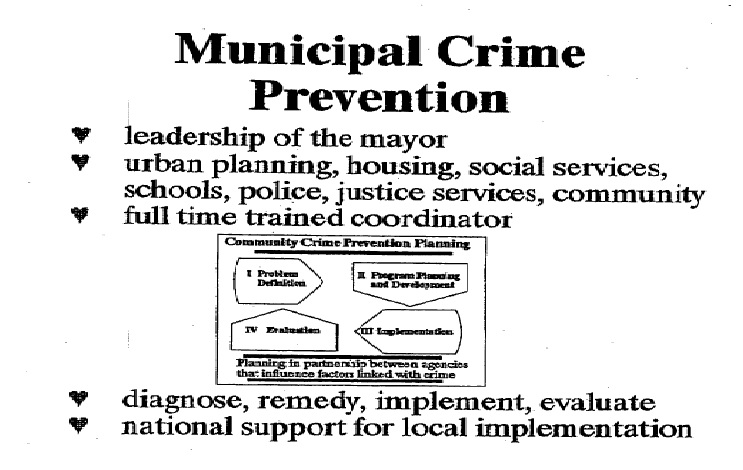
Love the heart bullet points!
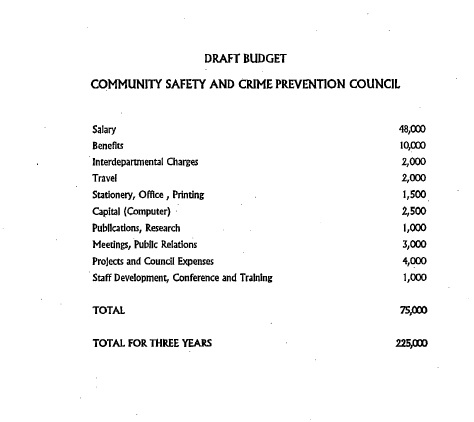
Well, there you have it folks, the presentation that launched a crime prevention through social development initiative in Waterloo Region, to the tune of $225,000 over 3 years. Such incredible growth and change over 20 years. If we had a spare $225,000 now…. well, we could do a lot of things. But one thing we would do is hire a really brilliant evaluator to capture and measure the trajectory of community change over the course of 20 years as a result of this thing we now know as the Waterloo Region Crime Prevention Council.
Can you imagine the things we would learn?
Has the WRCPC made a lasting impression on our community? What is that to you or your organization?
Posted on: December 30th, 2014 by Waterloo Region Crime Prevention Council
We’ve been in reflection mode this week at the WRCPC office. The time of year lends itself perfectly to this kind of ‘look back’ at the year that was 2014. I hope you are enjoying your own reflections. And, since we’re at it, why don’t we do some reflecting together, with the help of Smart on Crime.
We had such a variety of blog posts this year, ranging from what we were reading to crime stats, to special posts from Friends of Crime Prevention. Early in 2014, we wrapped up a year long examination of the root causes of crime. With the end of inREACH in Waterloo Region, we took some time to share what our community has learned from inREACH and engage our community in a follow up event in April where planned next steps. We even introduced you to some new words to enrich your vocabulary! And of course, we couldn’t help but challenge our community with some harder hitting posts.
Our readers are as diverse as our blog posts, which would explain the diversity of popular blogs this year. Here’s the round up of our top 14 posts from 2014.
- Public Opinion & Crime – Anthony Piscitelli
“Since 2006 the Canadian government has focused on being tough on crime. The policy approach continues to this day but it seems the Canadian public is starting to see these changes as a policy excess. Instead of focusing on punishment, public opinion polls suggest the government focus should be on prevention through education and social development programs.”
- Trent’s Trajectory: The dollars and $ense of crime prevention
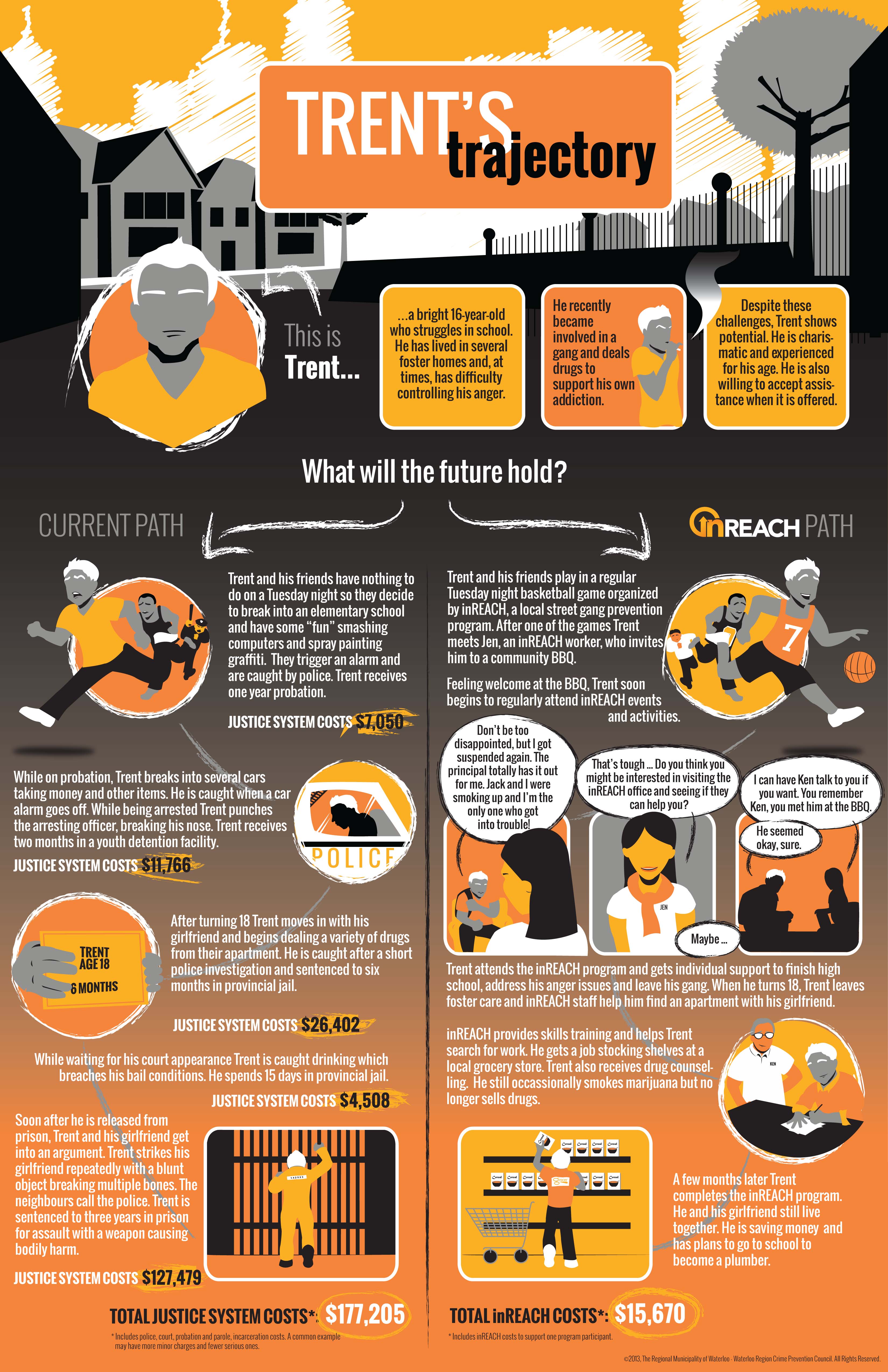
- A new story is needed – guest post by Friend of Crime Prevention, Doug McKlusky
“As a Friend of Crime Prevention, I believe that that the heart of crime prevention is through social and community development…..
Imagine neighbourhoods where everyone feels a sense of belonging, where inclusion trumps fear.
Imagine workplaces where people belong, and where respect and collaboration trump power and politics.
Imagine schools where belonging trumps bullying and streaming.”
- The new story continues…. – guest post by Friend of Crime Prevention, Doug McKlusky
“I do believe that many small actions will add up to a large action on the road to building a community of belonging. It can be as simple as acknowledging the presence of a homeless person in downtown Kitchener, they are part of our community, a friendly smile goes a long way in making a person feel like they belong. I challenge you to do something to make our community a community of belonging, smile at a stranger, volunteer somewhere in your community, it will make a difference, it will connect you!”
- Inspired by inREACH: Reflections of a youth outreach worker – Youth Outreach Worker, Krista McCann
“inREACH fostered a working environment that not only allowed us, but encouraged us to work outside of the box. I’d be lying to say the task was not daunting at first. In my previous experience working as a Youth Worker I had never been given such flexibility and confidence within a position to achieve the desired outcome; an outcome that was not based on the amount of programs ran or number of program participants but the ability to engage youth in their community.”
- Neighbourhood policing: A learning opportunity for Friends of Crime Prevention – WRCPC Student, Ryan Maharaj
“To usher in 2014, WRCPC hosted a learning event on ‘Neighbourhood Policing’. Naturally, Friends of Crime Prevention & WRCPC have a common interest with the police on all things related to crime prevention, community safety and well-being. Inspector Kevin Thaler from the Waterloo Regional Police Service was our guest to unveil the recent sweeping changes to their organizational structure, daily operations and dispatch methods. The results are what is now known as Neighbourhood Policing.”
- Between life and death: Responding to drug overdoses in Canada – former WRCPC student, Kayla Follet
This article appeared in the July 14, 2014 edition of the Waterloo Region Record.
- By the numbers: Wading through police-reported crime statistics 2013 – Anthony Piscitelli
“Statistics Canada released their annual Police-reported crime statistics 2013 report in July (and in French). There is always so much to sift through and interpret. Learn more from the Canadian Criminal Justice Association.”
- By the numbers: Hate crimes in Waterloo Region – Anthony Piscitelli
“In 2009, the Kitchener-Cambridge-Waterloo census metropolitan area (CMA) had the highest hate crime rate in Canada, according to police reported statistics. Did you catch the end of that sentence? “…..according to police reported statistics”. It might seem insignificant, but it might be the key to understanding why the 2009 hate crime rate in Waterloo Region is so high compared to other CMAs in Canada. “
- No clichés: A reflection on working with the youth of inREACH – guest post by Karl Garner
“Having been with inREACH, it became quite evident, that the youth we worked with often experienced clichés in their lives. They were labeled, stereotyped, and their behaviours were often predicted by the adult world around them, yet most of the time no one knew anything about them. Outside of where they lived, or who they hung out with, or the school they went to, or perhaps what they look like, do many even know these youth? The label which is the umbrella they live under is their cliché.”
- Ignoring what we’ve learned. Or, how to ensure street gangs become a real problem in Waterloo Region – Ryan Maharaj
“It’s easy to assume that we should apply what we’ve learned from the inREACH project to better support marginalized youth in our community. But have you every stopped to wonder, what happens if we ignore what we’ve learned? What if we shed the rose-coloured glasses and donned the shades of pessimism to see the barriers that stand in our way? What if we tried to see the glass half empty? How can we make a problem like street gangs in Waterloo Region, worse?”
- The community weighs in on the root causes of crime: change and action – Dianne Heise
“How do we get at the root causes of crime and prevent it from happening in the first place?
This isn’t a direct, straight answer, but, the Waterloo Region Crime Prevention Council believes part of the solution is to monitor the root causes of crime over time. Then we, as a community, can better understand and address the social, community and economic conditions associated with crime and victimization. Check out the Waterloo Region Crime Prevention Council’s report – A Snapshot in Time: The Root Causes of Crime in Waterloo Region to find out how we are doing in early childhood development, employment, community trust and other important indicators.”
….. and part 2 of The community weighs in on the root causes of crime: change and action
- Why communities need neighbourhood-based programming for youth – guest post by Courtney Didier, Alison Neighbourhood Community Centre
“We have worked with youth who have great dreams and aspirations for the future, but have trouble putting their vision into a workable plan. On the other side of the coin, we have worked with youth who have little to no confidence in their abilities, thus requiring a little more encouragement and a little more trial and error in determining what really gets them motivated and excited.”
- Lessons learned in a gang project – Dianne Heise and Rohan Thompson
“Gang Prevention Is…. a) addressing underlying issues, and, b) not about getting a kid to take off the bandana. We often heard – “we’ve got this kid, he’s in a gang – fix him.” So often in our case management and system navigation work, it wasn’t about getting this young person to take off his bandana or to stop hustling or whatever, we never approached the work in that fashion. But it was about the underlying issues and working on them. Mostly we were dealing with issues of poverty, untreated trauma, family breakdown, substance abuse, disengagement and lack of opportunities. These are the problems that young people and gang members and people in general are dealing with. We want to demystify that label of gang member that says their needs are different than any other groups. These same issues are the drivers behind the behaviours.”
So many great reads from 2014. But if you’re in the mood for something to watch, rather than read, might I suggest our newest video on Collaboration!
We look forward to bringing more great Smart on Crime blogs for you in 2015. Better yet, we love hearing your comments, reactions and responses to the posts and guest commentaries. We look forward to hearing more from you next year!























